Abstract
The increasing concern about the environmental impact of ingredients largely used as sunscreens today is pushing research towards new frontiers for the synthesis and degradation potential of innovative sun protection structures. This study deals with the design, synthesis, efficacy evaluation, and environmental impact of new photo-stable molecules at extended electronic conjugation and which have the ‘charge-transfer’ type of optical transition (push and pull). They efficiently perform absorption of electro-magnetic radiation in the UVB and UVA regions. A preliminary screening, dealing with a whole series of aromatic donors, led to the selection of a key substrate derived from waste material, provided with low environmental impact and largely available on the market. As far as the acceptor was concerned, an ester with cyan-acrylic structure and functionalized with aliphatic chains emerged as the most suitable. This allowed a shift of the λ of absorption in the range of the ultraviolet wavelengths. The synthesis procedures include an acid-catalyst-fitted esterification, condensation, and cold crystallization. It was continuously monitored with suitable characterization instruments (GC-MS, 1H NMR, 13C NMR), in order to avoid by-products and parasitic reactions. The resulting structures (patent pending) are composed by a furan core condensed with cyano-acrylic esters, derivatized with branched chains of hydrocarbons of medium length. The obtained structures are capable of good absorption in the range of wavelengths between 300 and 400 nm. Because of their structures, the new molecules are largely soluble in many common oils and cosmetic ingredients. The new molecules have been successively evaluated in terms of photo-stability, biodegradability, compatibility, and UVB-UVA protection capability, both in-vivo and in-vitro, in comparison with existing sunscreens.
1. Introduction
The tools of synthetic chemistry play a key role in the field of cosmetics. The possibility of manipulating or synthesizing new raw materials has long fascinated a still growing number of scientists, who are constantly searching for new compounds. The chemical synthesis of cosmetic raw materials, in general, is considered necessary when problems arise, for example, related to structural factors, or efficacy or compatibility with the formulation. Embedding of multiple functions within a single structure could also be beneficial for the cosmetics field []. Nowadays, sustainability, renewability, and low environmental impact are playing an increasingly relevant role in pushing scientific frontiers, following both legislative requirements and ethical guidelines []. Among the innovative synthetic compounds of interest in the cosmetic industry, UV filters are particularly relevant. They are special molecules or polymers capable of reducing the amount of incident UV radiation absorbed by the skin, which determines actinic damages and photo-aging []. UV radiation (UVR) from the sun is considered the main trigger of skin cancer. A traditional classification of UV rays is based on groups of wavelengths: UVA (315–400 nm), UVB (280–315 nm), and UVC (100–280 nm). Both UVA and UVB are linked to cancer pathogenesis: it is estimated that at least 10% of all new cancer cases could be prevented if people made proper and continuous use of sunscreens with broad-spectrum protection []. The efficacy of sunscreens is dependent on their capacity to efficiently absorb radiant energy. Broad-spectrum protection requires a proper combination of UVA and UVB filters [], but the main problems linked to UV filters are their synthetic nature and their photo-stability. Since these ingredients enter into mass-market goods and their final destiny is, for example, seawater, it is important that, once degraded, they do not become heavily polluting substances []. It is clear that a complete elimination of the environmental impact of these compounds is not possible by definition. Indeed, UV filters are synthesized, since there are no vegetal molecules available capable of covering the UV spectrum with high absorption efficiency. On the other hand, it could be challenging but possible to try and reduce their environmental impact. One way to play with this problem could be the adoption, for the synthesis of new compounds, of ingredients obtained from renewable resources and carry out chemical modifications on them to induce enhanced UV absorption []. This strategy is the key factor that has inspired this study. The renewable compounds obtained could be possible replacements for widely used synthetic UV filters.
2. Materials and Methods
2.1. Chemistry
All chemicals used for this study were supplied by Sigma Aldrich (Sigma-Aldrich Corporation, St. Louis, MO, USA). 1H and 13C NMR were recorded with a Bruker AVANCE III HD 400 MHz spectrometer (Bruker Corporation, Billerica, MA, USA). The UV spectrum was recorded on Perkin Elmer lambda 35 (PerkinElmer, Inc., Waltham, MA, USA), the sun protection factor (SPF) in vivo test was recorded on a Multiport Solar UV Simulator Model 601-300 watts (Solar Light Company, Inc., Glenside, PA 19038, USA), and the UVA in vitro efficacy was measured by a Labsphere UV-2000S Ultraviolet Trasmittance Analyzer (Labsphere, Inc., North Sutton, NH 03260, USA), Atlas Sun Test CPS (Atlas Material Testing Technology, Mount Prospect, IL, USA). The melting point was measured with a Stanford Research Systems Optimelt apparatus (Stanford Research Systems Sunnyvale, CA, USA).
2.2. Preliminary Screening
The most common UV filters in cosmetics were compared in terms of molecular structure, photo stability, and ability to full cover the UV spectrum of wavelengths. In general, these compounds contain an aromatic ring conjugated with a carbonyl group. Often, an electron-donating group, such as an amine or methoxy group, is substituted in the ortho- or para-position of the aromatic group []. Each molecular structure was examined in terms of electronic conjugation, and how this factor could change the absorption in an electro-magnetic field. Here follows a brief description of these molecules (Figure 1) and their chemical properties (Table 1) [].
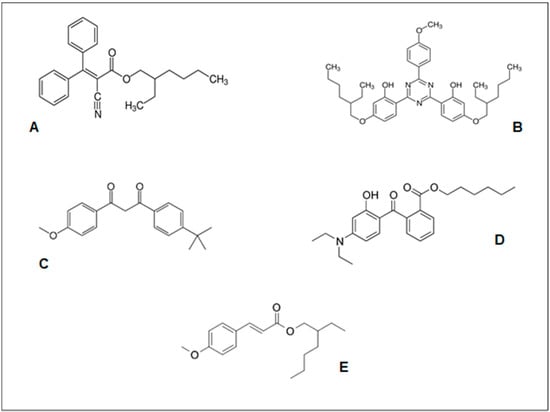
Figure 1.
Molecular structures of commercial UV filters. A = Octocrylene; B = Bis-Ethylhexyloxyphenol Methoxyphenyl Triazine; C = Butyl methoxydibenzoylmethane; D = Diethylamino hydroxybenzoyl hexyl benzoate; E = Ethyl Hexyl Methoxycinnamate.

Table 1.
Chemical properties of common UV filters.
• Octocrylene (Figure 1A)
This is one of most widely used UVB filters. Its molecular structure derives from the condensation of two phenyls with the ethyl-hexyl ester of cyano-acetic acid. It is an excellent UV absorber. In addition, it is a good solvent for many UV filters. Its lambda max is positioned on 310 nm, and its band covers the UVB range and a small portion of the UVA range.
• Bis-Ethylhexyloxyphenol Methoxyphenyl Triazine (Figure 1B)
This is one of the main UVA/UVB filters. It covers the entire UV spectrum. Its molecular structure is made of a triazine core functionalized with two ethyl-hexyl phenols and one methoxy-phenyl group. It has an excellent photo-stability and has two absorption peaks at 310 and 340 nm, respectively.
• Butylmethoxydibenzoylmethane (Figure 1C)
This is the most widely used UVA filter. Its molecular structure is based on a core of dibenzoyl methane functionalized with an iso-butyl and a methoxy group. Its spectrum is characterized by a lambda max positioned on 357 nm. Despite its excellent ability of covering the UVA range, it is not photo-stable. Consequently, its structure results in parasitic reactions [].
• Diethylamino Hydroxybenzoyl Hexyl Benzoate (DHHB) (Figure 1D)
This is a widely used UVA filter. Its molecular structure is that of a benzoyl benzoate ester functionalized with a hydroxyl group and di-ethylamine. Its lambda max is positioned at 354 nm. It has good photo-stability, and covers the wavelength range in the UVA portion of the UV spectrum.
• Ethylhexyl Methoxycinnamate (Figure 1E)
This is a widely used UVB filter and also good solvent. Its molecular structure is based on an ethyl-hexyl methoxy cinnamic ester. It has good photo-stability and compatibility with many other ingredients. Its UV spectrum is characterized by a 354 nm peak on the UVB range.
Following in Table 1 are the chemical properties of these compounds.
2.3. Molecular Design
Electronic energy transfer can occur if the donor and acceptor are separated by a distance greater than the collision diameter. In this case, the mechanism is referred to as long-range transfer or dipole-dipole mechanism. The efficiency of the process is dependent on the extent of overlap of the emission bands of the donor and the absorption bands of the acceptor. In short, this type of molecule contains a conjugated system, which allows electron delocalization after absorption of a photon of UV light []. As a result of preliminary screening, the donor-acceptor system was chosen on the basis on the premises given above []. In short, this molecule (Figure 2) contains a conjugated system, which allows for electron delocalization after absorption of a photon of UV light. The donor chosen is the furan ring, which was introduced starting from the corresponding aldehyde furfural; the acceptor is an ethyl-hexyl ester of cyano-acetic Acid. Upon condensation, a double bond is formed connecting the furan ring and both the ester and the cyano accepting groups. For the donor, the choice was led by sustainability and renewability concepts. Indeed, this reagent is obtained from the acid-catalysed transformation of pentosan sugars (C5) present in biomass [,]. For the acceptor, the choice was driven by its electron-accepting capabilities and moderate cost.
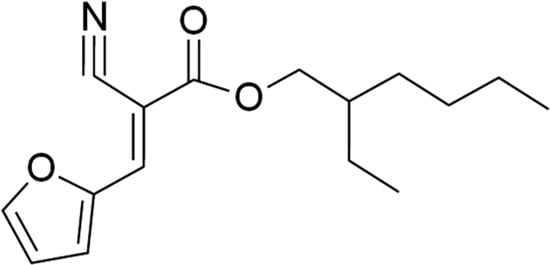
Figure 2.
Chemical structure of the new UV absorber.
2.3.1. Synthesis of 2-ethylhexyl 2-cyanoacetate
Small-scale reaction: 2-ethyl-1-hexanol (46.36 g, 0.356 mol), cyanoacetic acid (19.99 g, 0.235 mol), and p-Toluenesulfonic acid monohydrate (0.190 g, 0.01 mol) were mixed in a 100 mL flask equipped with a Dean-Stark trap. The mixture was refluxed, observing the formation of water droplets in the trap. The progress of the reaction was monitored by GC-MS. After 3 h, there was no further evolution in the relative intensities of GC-MS peaks. The crude reaction mixture was purified by fractional distillation under reduced pressure (10−1 bar). The excess 2-ethyl-1-hexanol was distilled at about 160 °C. The target 2-ethylhexyl 2-cyanoacetate was distilled at 200 °C (0.227 mol, 44.50 g, yield 96%). The repetition of the procedure on a 10-fold scaled-up protocol gave comparable results.
2.3.2. Synthesis of (E,Z)-2-Ethylhexyl 2-Cyano-3-(furan-2-yl)acrylate
Small-scale set up: 2-ethylhexyl 2-cyanoacetate (34.32 g, 0.174 mmol) and furane-2-carbaldheyde (16.72 g, 0.174 mmol) were mixed under mechanical stirring with neutral grade alumina (150 g). The resulting brownish crude product was dissolved in 100 mL of light petroleum ether and allowed to slowly crystallize at −20 °C. A fluffy white precipitate was formed and isolated by suction filtration to yield the pure title compound as a white powder (35.93 g, 0.131 mol, 75% yield). Large-scale set up: the same procedure was repeated using 2-ethylhexyl 2-cyanoacetate (83.83 g, 0.425 mol) and furane-2-carbaldheyde (40.84 g, 0.425 mmol), neutral grade alumina (110 g), and 500 mL of CH2Cl2. After 3 h, all volatiles were removed, and the solid residue was placed in a cellulose thimble and extracted by means of a Soxhlet apparatus with CH2Cl2 until there was a colorless extract. Removal of the solvent gave a brownish yellow oil that was combined with 300 mL of light petroleum ether and crystallized at −20 °C, like in the previous small-scale preparation. A 75% yield was consistently obtained.
2.4. Evaluation of Properties
2.4.1. UV Spectrum and Critical Lambda (λMAX)
A clear solution (10−5 M) of (E,Z)-2-ethylhexyl 2-cyano-3-(furan-2-yl)acrylate (solute) and dichloromethane (solvent) was prepared in 100 mL flask. The clear solution was subjected to UV light with a UV-Vis spectrophotometer in order to evaluate its absorption band, critical lambda (λMAX), and extinction coefficient (ε).
As result, the recorded spectrum was compared in terms of absorption bands to:
- 1-
- Butyl methoxydibenzoylmethane 10−5 M solution
- 2-
- Diethylamino hydroxybenzoyl hexyl benzoate 10−5 M solution.
2.4.2. Solubility
(E,Z)-2-ethylhexyl 2-cyano-3-(furan-2-yl) acrylate (2 g) was added to common cosmetic oils and some liquid UV filters (20 mL) to evaluate its solubility at 25 °C under magnetic stirring. The amount added was 10% w/w, comparable to the average use percentage of common filters in sunscreen formulations (octocrylene, ethylhexyl methoxycinnamate, etc.).
2.4.3. In Vivo Determination of the Sun Protection Factor (SPF)
A standard sunscreen formulation (STD S2) was selected (Table 2) and (E,Z)-2-ethylhexyl 2-cyano-3-(furan-2-yl)acrylate was added into it at 5% (Table 3). The SPF testing method involves the induction of a weak erythema by means of an appropriate sun simulator, under controlled conditions, on the back of at least 10 selected subjects. 20 ± 4 h after exposure, the erythema is visually assessed, and the individual sun protection factor is calculated. This corresponds to the ratio between the lowest UV doses that produces the first perceptible unambiguous erythema with defined borders, appearing over most of the field of UV irradiation (minimal erythemal dose, MED) on protected (MEDp) and on unprotected skin (MEDu). The sun protection factor is determined by calculating the arithmetical mean of the individual SPF values obtained for the subjects participating in the test. The methods follow the ISO 24444 []. The study has been conducted in accordance with the principles as described in the World Medical Association (WMA) Declaration of Helsinki for Medical Research Involving Human Subjects.

Table 2.
Standard sunscreen formulation (as defined by the ISO 24443).

Table 3.
Standard sunscreen formulation +5% (w/w) of (E,Z)-2-ethylhexyl 2-cyano-3-(furan-2-yl)acrylate.
2.4.4. In Vitro Determination of the UVA Protection Factor (UVA)
Details of this test are provided in Table 4. Starting from Table 5 (standard sunscreen formulation), the UVA filter butylmethoxy dibenzoyl methane was substituted by (E,Z)-2-ethylhexyl 2-cyano-3-(furan-2-yl)acrylate (5% w/w), as seen in Table 6. This method provides in vitro UVA protection factors (UVAPF), which are known to correlate well with the in vivo UVA protection factors determined by the persistent pigment darkening (PPD) method []. The test is based on the assessment of UV-transmittance through a thin film of sunscreen sample spread on a roughened substrate (PMMA plate), before and after exposure to a controlled dose of UV radiation (290–400 nm) from a defined UV source. All the sunscreen transmission data are adjusted by first converting them to absorbance data (before and after UV exposure) and then by multiplying by the same coefficient. The coefficient (coefficient C) is iteratively determined from the non-exposed sample’s absorbance data to provide a calculated in vitro SPF value equal to the SPF measured in vivo. The sunscreen sample is exposed to an irradiation dose proportional to the initial UVA protection factor UVAPF0, calculated from the adjusted absorbance data of the non-exposed sample. Using this method, the UVA protection factor (UVAPF), the SPFlabel/UVAPF ratio and the critical wavelength of the tested sunscreen product can be obtained. All these parameters are calculated from the absorbance data of the sample exposed to UV rays.

Table 4.
Details of the instruments.

Table 5.
Standard sunscreen formulation.

Table 6.
Standard sunscreen formulation +5% of (E,Z)-2-ethylhexyl 2-cyano-3-(furan-2-yl)acrylate.
3. Results
3.1. Chemistry—Analysis of Characterization
(E,Z)-2-ethylhexyl 2-cyano-3-(furan-2-yl)acrylate was prepared with a 60–75% yield. The structures of the title compound were confirmed by 1HNMR, 13CNMR spectroscopy, and GC-MS. The details of the spectral data for the prepared compound are here provided.
- 1H-NMR: (CDCl3, 400 MHz): δ 8.01 (1H,s, H-4), 7.75 (1H, d, J = 1.7 Hz, H-1), 7.40 (1H, d, J = 3.7 Hz, H-3), 6.66 (1H, dd, J = 3.7, 1.7 Hz, H-2), 4.23–4.20 (2H,m, H-5), 1.73–1.67 (1H, m, H-6), 1.48–1.29 (8H, m, H-7, H-8, H-9, H-11), 0.96–0.88 (6H,m, H-10, H-12).
- 13C NMR (CDCl3, 100 MHz): δ 162.73 (COO), 148.79 (C-γ), 148.14 (C-β), 139.35 (C-1), 121.51 (C-2), 115.16 (CN), 113.80 (C-3), 98.81 (C-α), 68.90 (C-5), 38.77 (C-6), 30.29 (C-7), 28.89 (C-8), 23.74 (C-9), 22.90 (C-11), 13.98 (C-10), 10.97 (C-12)
- GC-MS: 10.35 min
3.2. Chemistry—Determination of Melting Point
Melting Point (m.p.): 38.8 °C.
3.3. Evaluation of Sun Protection Properties
3.3.1. UV Spectrum and Critical Lambda (λMAX)
The UV spectrum of a solution (10−5 M) containing (E,Z)-2-ethylhexyl 2-cyano-3-(furan-2-yl)acrylate was recorded with a calibrated UV-VIS spectrophotometer. The spectrum is provided in Figure 3. The λMAX is on 339 nm, in the wide range of UVB and UVA, characterized by a large band that spans from 300 nm to 370 nm and an extinction coefficient of ε = 4000 m2/mol. Figure 4 shows the behavior of butyl methoxydibenzoylmethane and DDHB compared to (E,Z)-2-ethylhexyl 2-cyano-3-(furan-2-yl) acrylate. The band of methoxydibenzoylmethane is characterized by a large band that starts from 310 to 390 nm with a λMAX = 357 nm; the band of DHHB covers from 320 to 380 and its λMAX is on 354 nm.
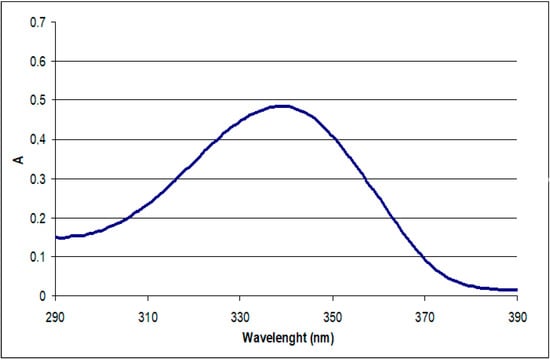
Figure 3.
UV spectrum of a solution 10-5 M of (E,Z)-2-ethylhexyl 2-cyano-3-(furan-2-yl)acrylate.
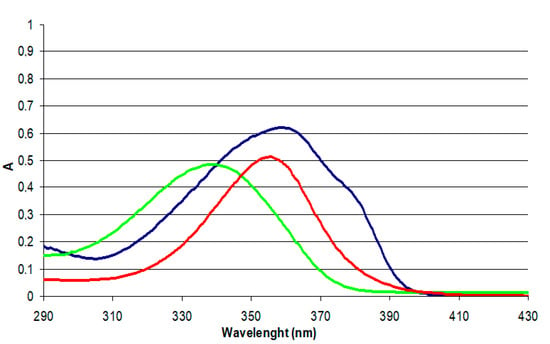
Figure 4.
Overlapped UV spectra: butyl methoxydibenzoylmethane (blue line), DDHB (red line), and (E,Z)-2-ethylhexyl 2-cyano-3-(furan-2-yl)acrylate (Green line).
3.3.2. Solubility
(E,Z)-2-ethylhexyl 2-cyano-3-(furan-2-yl)acrylate shows a perfect solubility at 25 °C in these solvents:
- 1-
- Di-Ethyl-Hexyl Adipate
- 2-
- Octocrylene
- 3-
- Octyl Methoxy Cinnamate
- 4-
- Ethyl Hexyl Salicylate
- 5-
- Ethanol.
3.3.3. In Vivo Determination of the Sun Protection Factor (SPF)
The method has been explained in Materials and Methods section, while the details of the SPF test are provided in Table 7.

Table 7.
Results of the SPF test.
3.3.4. In Vitro Determination of UVA Protection Factor (UVA)
The results of this test are provided in Figure 5 (absorbance of S2 standard), Figure 6 (UVA of S2 standard), Figure 7 (absorbance of S2 +(E,Z)-2-ethylhexyl 2-cyano-3-(furan-2-yl)acrylate), and Figure 8 (UVA of S2 standard + (E,Z)-2-ethylhexyl 2-cyano-3-(furan-2-yl)acrylate). The blue line represents the spectrum before exposure, and the red line, after exposure. In Figure 5, the absorbance in function on the wavelengths before and after exposure of the reference standard is shown. The spectrum A vs λ shows two large bands with a minimum between 330 and 340 nm. This optical transition is characteristic of methoxydibenzoylmethane, the UV filter used as a standard. In Figure 6, the data in Figure 5 is reported in function of mAF(λ) before and after exposure. The data presented by the ordinates are the absorbance values multiplied by coefficient C. In Figure 7, the absorbance in function on the wavelengths, before and after exposure of the reference standard with (E,Z)-2-ethylhexyl 2-cyano-3-(furan-2-yl)acrylate, is given. In Figure 8, the Figure 7 data in function of mAF(λ) are reported.
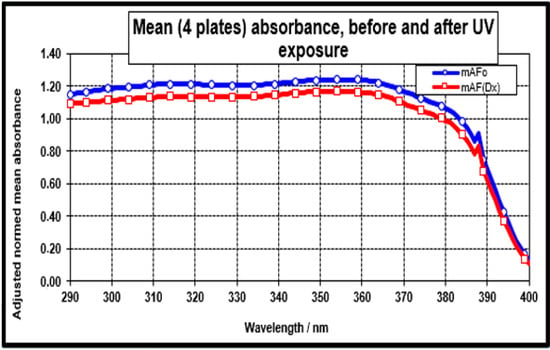
Figure 5.
Absorbance in function on wavelengths before and after exposure of the standard sunscreen.
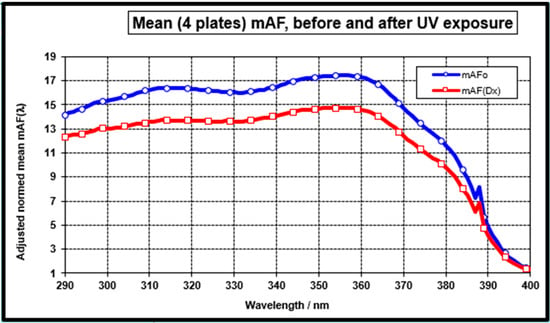
Figure 6.
mAF(λ) in function of wavelengths before and after exposure of the standard sunscreen formulation.

Figure 7.
Absorbance in function on wavelengths before and after exposure of the standard sunscreen formulation with (E,Z)-2-ethylhexyl 2-cyano-3-(furan-2-yl)acrylate.
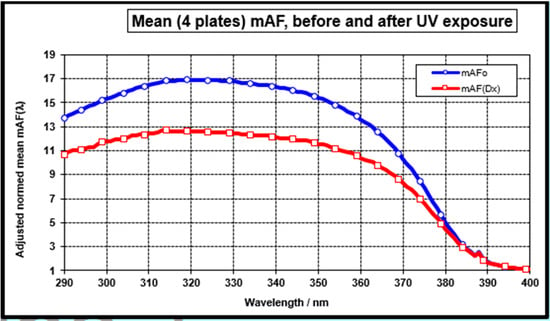
Figure 8.
mAF(λ) in function of wavelengths before and after exposure of the standard sunscreen formulation with (E,Z)-2-ethylhexyl 2-cyano-3-(furan-2-yl)acrylate.
In Table 8, the results of the UVA protection test are reported.

Table 8.
Results of UVA test.
4. Discussion
4.1. Chemistry
The 1HNMR and 13CNMR confirm that the synthesis reaction has been successful. For 1HNMR, all peaks were integrated and characterized in order to understand if the recorded molecule coincided with our target. Starting from the left of the 1HNMR spectrum, the aromatic hydrogens in the region between 8.00 and 6.50 ppm are clearly seen, the hydrogens are near the carbonyl at about 4.00 ppm and in the right portion of the spectra between 1.50 and 0.80, and the hydrogens of the aliphatic chain are also easily observed. For 13CNMR, all peaks were characterized. Even in this spectrum, starting from the right, we see the carbonyl carbon atom at about 160 ppm, in the region between 150 and 110 ppm the aromatic carbons, and in the right portion of the spectrum, the aliphatic carbons of the cyano-acrylate ester. The λMAX lambda max and molar extinction coefficient have been determined. They confirm that the molecule is capable of absorbing UV radiation with a good value of excited states.
4.2. Evaluation Properties
4.2.1. UV Spectrum and Critical Lambda (λMAX)
A clear diluted solution (10−5 M) of (E,Z)-2-ethylhexyl 2-cyano-3-(furan-2-yl)acrylate in dichloromethane was examined on UV-Vis spectrophotometer. The UV spectrum (Figure 3) confirms that this compound is capable of absorbing a portion of UV radiation. In particular, the λMAX is positioned at 339 nm, and the covering band starts at 300 nm and ends at about 370 nm. The extinction coefficient confirms that this new absorber has a large value of excited states. The overlapped UV spectra (Figure 4) shows the difference in terms of covering band between (E,Z)-2-ethylhexyl 2-cyano-3-(furan-2-yl)acrylate and the two common filters (butyl methoxydibenzoylmethane, DDHB). If the UVA spectrum is completely covered by butyl methoxydibenzoylmethane and DDHB, the (E,Z)-2-ethylhexyl 2-cyano-3-(furan-2-yl)acrylate shows a shifted covering band that it is capable of filling the wavelength portion that is typically not covered by many UVA filters (300–340 nm).
4.2.2. Solubility
(E,Z)-2-ethylhexyl 2-cyano-3-(furan-2-yl)acrylate shows very good solubility (25 °C) in different common oils and UV filters with different polarity.
4.2.3. In Vivo Determination of the Sun Protection Factor (SPF)
(E,Z)-2-ethylhexyl 2-cyano-3-(furan-2-yl) acrylate shows good absorption properties, also in a finished solar formulation. The results confirm that 5% (w/w) of this new molecule can raise the SPF values by about 2 units, and that it can be used as a UVB filter in combination with other filters.
4.2.4. In Vitro Determination of UVA Protection Factor (UVA)
The graphs reported above confirm that (E,Z)-2-ethylhexyl 2-cyano-3-(furan-2-yl) acrylate has good capability to absorb a large portion of UVA radiation. As compared between two graphs (Figure 5 and Figure 6), it is easy to see that the absorbance gap between the curves before and after the exposure of the two examined solar formulations is not significant. On the contrary, two other graphs (Figure 7 and Figure 8) show that the portion of wavelengths covered by (E,Z)-2-ethylhexyl 2-cyano-3-(furan-2-yl) acrylate is not fully comprehensive of the UVA range, and it also has a maximum at 320 nm, in the wavelength range which is not covered by butyl methoxydibenzoylmethane. These last results justify the different values of final UVA protection (Table 8) between the standard solar formulation S2 and the formulation containing 5% (E,Z)-2-ethylhexyl 2-cyano-3-(furan-2-yl)acrylate.
5. Conclusions
In this study, the synthesis of (E,Z)-2-ethylhexyl 2-cyano-3-(furan-2-yl)acrylate is reported, and its principal properties were evaluated. This was synthesized with a scalable and inexpensive protocol. Its spectrum has a large band from 300 to 400 nm and λMAX = 339 nm. It has a good solubility and compatibility in the presence of many oils and sunscreens. The SPF and UVA values confirm that the new compound is capable of absorbing UV radiation in both portions of UVA and UVB rays. This is the first step in the research on this new class of UV filters, based on an eco-friendly approach. The next research steps could be a dimerization or a chemical substitution of the hetero-aromatic ring, in order to enhance the performance of this new category of compounds.
Author Contributions
Conceptualization, B.G., B.L., R.L., L.N.; Methodology, B.G., B.L.; Investigation, B.G., B.L., R.L., L.N.; Data Curation, B.G., L.N.; Writing—Original Draft Preparation, B.G.; Writing—Review & Editing, B.L., R.L., L.N.; Supervision, R.L., L.N. All authors have read and agreed to the published version of the manuscript.
Funding
This research received no external funding.
Conflicts of Interest
The authors declare no conflict of interest.
References
- Metzger, J.O.; Eissen, M.C.R. Chimie, Concepts on the contribution of chemistry to a sustainable development: Renewable raw materials. C. R. Chim. 2004, 7, 569–581. [Google Scholar] [CrossRef]
- Beerling, J.; Sahota, A. Sustainability: How the Cosmetics Industry Is Greening Up; John Wiley & Sons: London, UK, 2014. [Google Scholar]
- Schlumpf, M.; Durrer, S.; Faass, O.; Ehnes, C.; Fuetsch, M.; Gaille, C.; Timms, B. Developmental toxicity of UV filters and environmental exposure: A review. Int. J. Androl. 2008, 31, 144–151. [Google Scholar] [CrossRef] [PubMed]
- D’Orazio, J.; Jarrett, S.; Amaro-Ortiz, A.; Scott, T. UV Radiation and the Skin. Int. J. Mol. Sci. 2013, 14, 12222–12248. [Google Scholar] [CrossRef] [PubMed]
- Serpone, N.; Dondi, D.; Albini, A. Inorganic and organic UV filters: Their role and efficacy in sunscreens and suncare products. Inorg. Chim. Acta 2007, 360, 794–802. [Google Scholar] [CrossRef]
- Tsui, M.M.; Leung, H.W.; Wai, T.C.; Yamashita, N.; Taniyasu, S.; Liu, W.; Murphy, M.B. Occurrence, distribution and ecological risk assessment of multiple classes of UV filters in surface waters from different countrie. Water Res. 2014, 67, 55–65. [Google Scholar] [CrossRef] [PubMed]
- Hitce, J.; Xu, J.; Brossat, M.; Frantz, M.C.; Dublanchet, A.C.; Philippe, M.; Dalko-Csiba, M. UN-sustainable development goals: How can sustainable/green chemistry contribute? Green chemistry as a source of sustainable innovations in the cosmetic industry. Curr. Opin. Green Sustain. Chem. 2018, 13, 164–169. [Google Scholar] [CrossRef]
- Giokas, D.L.; Salvador, A.; Chisvert, A. UV filters: From sunscreens to human body and the environment. TrAC Trends Anal. Chem. 2007, 26, 360–374. [Google Scholar] [CrossRef]
- Osterwalder, U.; Herzog, B. Chemistry and Properties of Organic and Inorganic UV Filters. In Clinical Guide to Sunscreens and Photoprotection; CRC Press: Boca Raton, FL, USA, 2008; pp. 27–54. [Google Scholar]
- Mturi, G.J.; Martincigh, B.S. Photostability of the sunscreening agent 4-tert-butyl-4-methoxydibenzoylmethane (avobenzone) in solvents of different polarity and proticity. J. Photochem. Photobiol. A Chem. 2008, 200, 410–420. [Google Scholar] [CrossRef]
- Gasparro, F.P. Sunscreen Photobiology: Molecular, Cellular and Physiological Aspects; Springer: Cham, Switzerland, 1997; pp. 11–42. [Google Scholar]
- Zhu, Y.; Li, W.; Lu, Y.; Zhang, T.; Jameel, H.; Chang, H.M.; Ma, L. Production of furfural from xylose and corn stover catalyzed by a novel porous carbon solid acid in γ-valerolactone. RSC Adv. 2017, 7, 29916–29924. [Google Scholar] [CrossRef]
- Mariscal, R.; Maireles-Torres, P.; Ojeda, M.; Sádaba, I.; Granados, M.L. Furfural: A renewable and versatile platform molecule for the synthesis of chemicals and fuels. Energy Environ. Sci. 2016, 9, 1144–1189. [Google Scholar] [CrossRef]
- COSMETICS–Sun Protection Test Methods-In Vivo Determination of the Sun Protection Factorn (SPF). ISO 24444:2010. Available online: https://www.iso.org/standard/46523.html (accessed on 30 November 2019).
- Moyal, D.; Chardon, A.; Kollias, N. Determination of UVA protection factors using the persistent pigment darkening (PPD) as the end point. (Part 1) Calibration of the method. Photodermatol. Photoimmunol. Photomed. 2000, 16, 245–249. [Google Scholar] [CrossRef]
© 2020 by the authors. Licensee MDPI, Basel, Switzerland. This article is an open access article distributed under the terms and conditions of the Creative Commons Attribution (CC BY) license (http://creativecommons.org/licenses/by/4.0/).